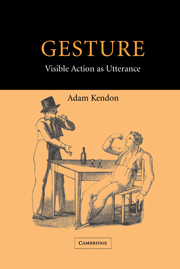Book contents
- Frontmatter
- Contents
- Acknowledgments
- 1 The domain of gesture
- 2 Visible action as gesture
- 3 Western interest in gesture from Classical Antiquity to the eighteenth century
- 4 Four contributions from the nineteenth century: Andrea de Jorio, Edward Tylor, Garrick Mallery and Wilhelm Wundt
- 5 Gesture studies in the twentieth century: recession and return
- 6 Classifying gestures
- 7 Gesture units, gesture phrases and speech
- 8 Deployments of gesture in the utterance
- 9 Gesture and speech in semantic interaction
- 10 Gesture and referential meaning
- 11 On pointing
- 12 Gestures of ‘precision grip’: topic, comment and question markers
- 13 Two gesture families of the open hand
- 14 Gesture without speech: the emergence of kinesic codes
- 15 ‘Gesture’ and ‘sign’ on common ground
- 16 Gesture, culture and the communication economy
- 17 The status of gesture
- Appendix I Transcription conventions
- Appendix II The recordings
- References
- Index
8 - Deployments of gesture in the utterance
Published online by Cambridge University Press: 05 February 2015
- Frontmatter
- Contents
- Acknowledgments
- 1 The domain of gesture
- 2 Visible action as gesture
- 3 Western interest in gesture from Classical Antiquity to the eighteenth century
- 4 Four contributions from the nineteenth century: Andrea de Jorio, Edward Tylor, Garrick Mallery and Wilhelm Wundt
- 5 Gesture studies in the twentieth century: recession and return
- 6 Classifying gestures
- 7 Gesture units, gesture phrases and speech
- 8 Deployments of gesture in the utterance
- 9 Gesture and speech in semantic interaction
- 10 Gesture and referential meaning
- 11 On pointing
- 12 Gestures of ‘precision grip’: topic, comment and question markers
- 13 Two gesture families of the open hand
- 14 Gesture without speech: the emergence of kinesic codes
- 15 ‘Gesture’ and ‘sign’ on common ground
- 16 Gesture, culture and the communication economy
- 17 The status of gesture
- Appendix I Transcription conventions
- Appendix II The recordings
- References
- Index
Summary
In examining examples of utterances in which speech and gesture are employed together, we have seen how the gesture phrases commence in advance of the words to which their strokes appear to be connected semantically. We suggest that this is best accounted for by supposing that it is only in this way that the strokes of the gesture phrases can be produced so that they are coordinate with what is expressed with the semantic nuclei of the co-occurring spoken phrases. This semantic coherence (or ‘co-expressiveness’ as McNeill has called it) of gesture phrase stroke with spoken expression is evidence that the gestural component and the spoken component of an utterance are produced under the guidance of a single plan. We suggest, however, that the conjunction of the stroke with the informational centre of the spoken phrase is something that the speaker achieves. In creating an utterance that uses both modes of expression, the speaker creates an ensemble in which gesture and speech are employed together as partners in a single rhetorical enterprise.
Consider again Example 1 and Example 2 from Chapter 7. In both the speaker introduces a pause in the speech which appears to be related to the process of organizing the gestural component. In Example 1 the speaker paused for a moment after he had finished pronouncing the word that was semantically coordinate with the stroke, so that the two-part stroke could be completed before he went on to the next words of the spoken component.
- Type
- Chapter
- Information
- GestureVisible Action as Utterance, pp. 127 - 157Publisher: Cambridge University PressPrint publication year: 2004



